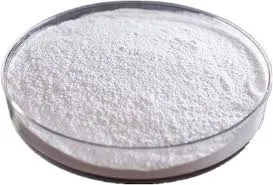
Dec . 25, 2024 17:07 Back to list
Hydroxyethyl Cellulose CAS Number and Its Applications in Various Industries
Hydroxyethyl Cellulose An Overview
Hydroxyethyl cellulose (HEC) is a water-soluble polymer that has garnered significant attention across various industries, primarily in food, pharmaceuticals, personal care products, and construction. This cellulose derivative is synthesized from natural cellulose by etherification with ethylene oxide. The resulting compound exhibits unique properties that make it versatile for numerous applications. Within this article, we will explore the chemical structure of HEC, its properties, applications, and safety profile.
Chemical Structure and Properties
Hydroxyethyl cellulose is formed from the cellulose backbone, which is a linear chain of D-glucose units linked by β-1,4-glycosidic bonds. When ethylene oxide reacts with cellulose, it introduces hydroxyethyl groups (-OCH2CH2OH) to the cellulose polymer. The degree of substitution, which refers to the average number of hydroxyethyl groups per glucose unit, drastically influences the polymer's solubility, viscosity, and overall performance in different applications.
HEC is characterized by its excellent water solubility, which allows it to form clear, viscous solutions. It exhibits pseudoplastic behavior, meaning its viscosity decreases under shear stress, making it easy to handle during mixing and application. Additionally, HEC possesses emulsifying, thickening, and film-forming abilities, which contribute to its widespread usage in various formulations.
Applications
1. Pharmaceuticals Hydroxyethyl cellulose serves as a crucial ingredient in pharmaceutical preparations. It is often used as a thickener, binder, and stabilizer in various dosage forms, such as gels, ointments, and tablets. Its biocompatibility and low toxicity make it an ideal choice for topical applications and controlled drug delivery systems.
2. Personal Care Products In the cosmetics and personal care industry, HEC is utilized for its thickening and emulsifying properties. It is commonly found in lotions, shampoos, and creams, where it enhances product consistency and stability. Additionally, HEC contributes to the sensory feel of products, providing a smooth application and improved skin feel.
hydroxyethyl cellulose cas number

3. Food Industry HEC is approved for use in food products and serves as a thickening agent, stabilizer, and emulsifier in various formulations. It aids in improving the texture and quality of processed foods, such as sauces, dressings, and dairy products, by preventing separation and enhancing mouthfeel.
4. Construction The construction industry also benefits from the unique properties of hydroxyethyl cellulose. It is often incorporated into cement-based compositions, adhesives, and plaster. HEC improves workability and water retention, ensuring optimal performance during application and enhancing the durability of the final product.
5. Coatings and Inks HEC is widely used in paints, coatings, and inks due to its rheological properties. It enhances the spreading and leveling characteristics, providing a smooth finish. Its ability to create a stable suspension of pigments and fillers helps in producing high-quality coatings with excellent performance.
Safety and Environmental Considerations
Hydroxyethyl cellulose is generally considered safe for use in food, pharmaceuticals, and personal care products. Regulatory bodies, including the U.S. Food and Drug Administration (FDA) and the European Food Safety Authority (EFSA), have approved its usage within specified limits. However, as with any additive, it is essential to ensure adherence to recommended guidelines to safeguard consumer health.
From an environmental perspective, HEC is derived from renewable resources, making it a more sustainable alternative compared to petroleum-based polymers. Additionally, its biodegradability presents an advantage when considering waste management and environmental impact.
Conclusion
In conclusion, hydroxyethyl cellulose is a versatile and valuable polymer with a broad range of applications across multiple industries. Its unique properties, such as water solubility, thickening ability, and biocompatibility, make it a preferred choice in pharmaceuticals, personal care, food, construction, and coatings. With its safety profile and environmental sustainability, HEC is likely to continue playing a significant role in innovation and product development in the coming years. As industries evolve and the demand for high-performance materials increases, the importance of hydroxyethyl cellulose will undoubtedly remain prominent.
-
Versatile Hpmc Uses in Different Industries
NewsJun.19,2025
-
Redispersible Powder's Role in Enhancing Durability of Construction Products
NewsJun.19,2025
-
Hydroxyethyl Cellulose Applications Driving Green Industrial Processes
NewsJun.19,2025
-
Exploring Different Redispersible Polymer Powder
NewsJun.19,2025
-
Choosing the Right Mortar Bonding Agent
NewsJun.19,2025
-
Applications and Significance of China Hpmc in Modern Industries
NewsJun.19,2025







